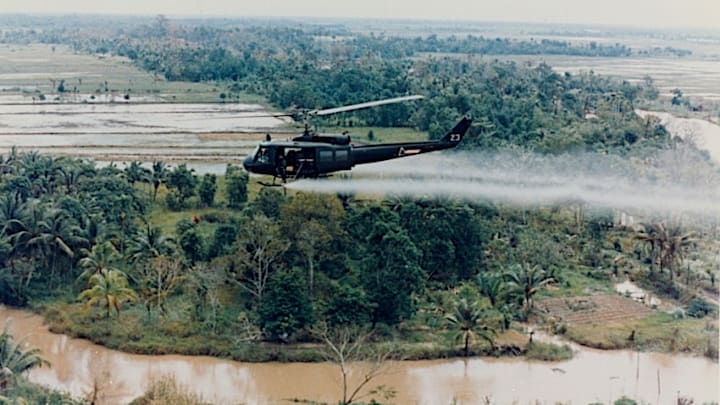One of the U.S. military’s many challenges in the Vietnam War was fighting through a seemingly endless jungle that the enemy knew better than Americans ever could. Its solution was Operation Ranch Hand: From 1962 to 1971, the Air Force sprayed 19 million gallons of herbicides over Vietnam. The two objectives were improving visibility by defoliating trees and plants and destroying the Viet Cong’s food supply.
Agent Orange, the chemical most frequently used, was later linked to cancer, birth disorders, and other life-threatening health complications. The extent of its effect on both American service members and the Vietnamese population remains perhaps the last great controversy of the war.
- The Origins of Agent Orange
- The Health Effects of Agent Orange Contamination in Vietnam
- The Impact on U.S. Service Members and their Families
- A Historic Class Action Suit
The Origins of Agent Orange
In the 1940s, botanist Arthur Galston discovered that triiodobenzoic acid, which regulates plant growth, could cause soybean plants to quickly shed their leaves if applied in excessive amounts. His work became the basis for a synthetic auxin, a type of growth-regulating plant hormone. (Galston later campaigned against its usage in war.)
The British military was the first to use a form of this defoliant in warfare, reducing the plant cover concealing insurgents in present-day Malaysia [PDF] in the 1950s.
Agent Orange was one within an arsenal of “rainbow herbicides” used by the U.S. Air Force in Vietnam, each given a colloquial name based on the color of the bands on the drums in which it was stored. Agent Orange was the preferred chemical because it was quickest, defoliating leaves within three or four weeks, compared to four months for the second-fastest solution, Agent White.
The Department of Defense began phasing out its usage after the National Institutes of Health and the American Association for the Advancement of Science published reports in 1969 that suggested Agent Orange caused birth defects in lab animals.
The Health Effects of Agent Orange Contamination in Vietnam
Agent Orange accounted for 11.2 million of the 19 million gallons of herbicides sprayed on Vietnam. By some estimates, these military herbicides were sprayed on 3.6 million acres, or nearly 10 percent of the land area of South Vietnam.
The effects of Agent Orange exposure are long-lasting. Its dioxins, a group of highly toxic organic compounds, have been found in the blood and breast milk of people decades after exposure. The main health consequences are birth defects and cancer.

The government of Vietnam contends that up to 4 million of its citizens were exposed to Agent Orange, resulting in as many as 3 million cases of disability and illness. The U.S. government has disputed these numbers. The Red Cross of Vietnam links Agent Orange exposure to as many as 1 million cases.
A team of Canadian researchers found that Agent Orange dioxins were still present in soil in heavily sprayed areas in the 1990s and children in these areas were more likely to have cleft palates, extra fingers or toes, and developmental disabilities.
The Impact on U.S. Service Members and their Families
Somewhere between 2.6 and 3.8 million U.S. service members were exposed to Agent Orange. Studies have consistently shown that Vietnam veterans have greater risk for developing several types of cancer than service members not deployed to the country.
Since 1991, the Veterans Administration has provided Vietnam service members treatment for these types of cancer—plus some other diseases linked to Agent Orange—presuming them to be due to exposure. People who attribute their cancer to exposure to Agent Orange on some military bases and surrounding areas have fought, with varying degrees of success, to be covered as well.
The VA has been more conservative with benefits to cover the costs of birth disorders in veterans’ children. Since 1984, researchers have correlated Agent Orange exposure to birth disorders, but the VA has largely discarded this research as inconclusive. It only covers one birth condition, spina bifida, linked to Agent Orange in descendants of male Vietnam veterans, much to the frustration of some disabled descendants of service members.
A Historic Class Action Suit
Veterans have also sought relief from the nine chemical companies that made Agent Orange for the U.S. military, which included Dow Chemical and Monsanto. In 1978, an Army veteran diagnosed with terminal cancer sued Dow for $10 million in what snowballed into one of the largest and most complex class action suits in history. In 1984, seven companies settled, creating a $180 million fund to compensate about 250,000 injured veterans without admitting guilt and for protection from further claims. The plan capped the lifetime benefits to each of 20,000 “totally disabled” veterans at $12,000.
Read More History of the Vietnam War:
